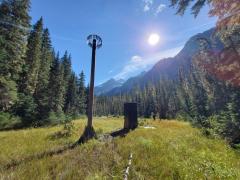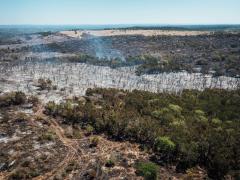Drought Brings the Heat: New Research Finds Drought Lengthens Heat Waves
Drought and heat often appear together, but new research funded by NOAA’s National Integrated Drought Information System found that drought can lengthen heat waves occurring at the same time.
Drought and extreme temperatures can dry out vegetation, leading to billions of dollars in agricultural losses and building up fuels that can ignite in wildfires. These hazards can also reduce water supplies and lead to low river levels, impacting freight transportation on major waterways like the Mississippi River. This new understanding of how drought and heat intersect will help economic sectors anticipate and prepare for their impacts.
In a recently published study in the Journal of Applied Meteorology and Climatology, researchers examined the influence of drought on heat wave intensity, duration, and human exposure to extreme heat using air temperature, soil moisture, and soil temperature observations from across the country.
Researchers found drought increased the average duration of heat waves by 13-48 hours at most of the weather stations included in the study. Nationally, heat waves during drought had an average of about 9 more hours of extreme heat (hours where temperatures are in the top 90th percentile of historical conditions) compared to heat waves that occur in non-drought conditions.
When heat waves occur at the same time as drought, people face increased risk of heat exposure, particularly in the late afternoon to early evening, compared to a heat wave on its own. This includes both exposure to higher temperatures and a longer length of exposure to heat. Heat waves more often co-occur with drought in the western United States, particularly the Southwest from Texas to California—areas that have seen periods of long-term drought over the last 25 years. Even in the eastern United States, though, heat waves co-occurring with drought resulted in higher daily maximum temperatures compared to heat waves without drought.
Soil moisture is likely one component driving this phenomenon. It is understood that dry soils reduce local evapotranspiration (ET) rates, but this study also found that the soils retained more heat. The combination of reduced ET and warmer soils likely allowed heat to escape into the atmosphere, driving warmer air temperatures. This effect is particularly impactful in the early evening, driving warmer evenings. Measuring soil moisture and soil temperature conditions therefore could improve assessments of how crops, economies, wildfire risk, infrastructure, and human health are impacted by extreme heat.
Interested in current efforts to integrate and improve soil moisture data? The National Coordinated Soil Moisture Monitoring Network (NCSMMN) is a network of federal and state agencies, soil moisture scientists, state mesonet operators, and others working to provide high-quality, nationwide soil moisture information—supporting early warning of and increased resilience to drought.









